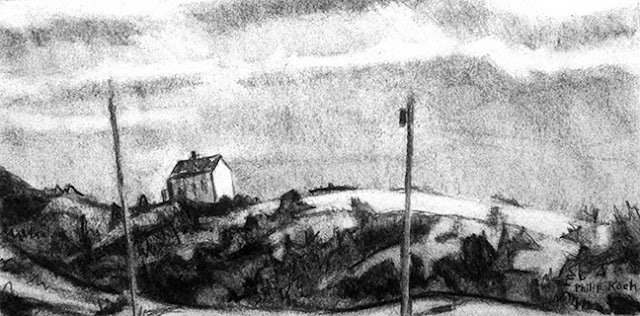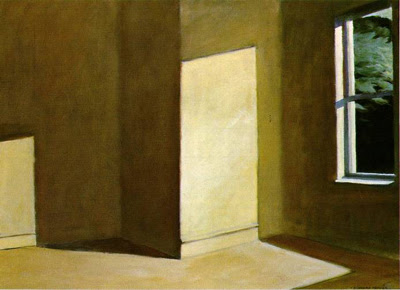Reading Public Museum
I literally stumbled into a fabulous show a couple weeks back. I was driving back from visiting the Edward Hopper House Art Center in Nyack, NY where I'll be having a show and giving an artists' talk at the end of March. Stopped in the Reading Public Museum (I love that name) in Pennsylvania and saw their big American Impressionism: The Lure of the Artists' Colony exhibition. Unfortunately between organizing the show at the Hopper House Art Center and writing an article on my traveling museum exhibition Unbroken Thread for Fine Art Connoisseur magazine (which I finally finished today!), I haven't had time until now to post about this amazing show at the Reading Museum. It is drop dead gorgeous. Drawn entirely from the Museum's Permanent Collection, it is simply one of the strongest painting shows I've ever seen. That's the good news. The bad news is it ends January 29th. Maybe if you drop everything...
Above is a knockout painting by the Boston Impressionist William Paxton (1869-1941), Girl with a Hand Mirror from 1915. This painting has a remarkable textural feel to it. The way the hair falls over the woman's torso is just perfect. I love the counter motion Paxton set up between the direction of the falling hair and the bold diagonal pattern on her dress. The sense of solid volumes bathed in varying light and set into motion is simply amazing. If the Museum suddenly loses its mind and de-accessions this painting, please everyone remember I have a birthday coming up.
Below is a Charles W. Hawthorne (American, 1872-1930) oil, A Study in White, circa 1900. Look at how Hawthorne plants the woman squarely between two "bookends" of the dark leafy stalk at the left and the sharp dark shadow peeking out from behind her dress as it slides off the right hand side. It's not a small painting, and when you see him convince us about those spots of sunlight on her dress (which would have moved every 10 minutes), you realize this is a very good painting.
Hawthorne's oil also was conveniently vertical so they could make it into a handsome banner and hang it outside the Museum entrance.
It just keeps getting better. Here's their oil by John Singer Sargent (American, well partly at least, 1856-1925), Man Reading (Nicola d'Inverno) from around 1904-1905. The range of whites and greys playing off the ochres and oranges in his forearm seems so beautifully chosen. And have you ever seen a book painted with more personality than this one? I love the slightly warmer whites Sargent sneaks into the books pages contrasting against the stark colder whites of the sheets.
As I said earlier I've just been writing an article for Fine Art Connoisseur on how artists from the past have influenced my own work as a contemporary painter. I began my journey into painting under the spell of Rothko and Frank Stella in the 1960's. And I learned a lot about color and proportion. But after a year or so I began to miss the sense of light and shadow one could find in the older painters. Like this masterful Sargent. I realized that the 19th century painters routinely celebrated something my flat acrylic abstractions couldn't touch. So began my long march to teach myself how to draw in the traditional sense and to figure out what realist painting was going to mean to me. Among the paintings I remember looking at in art books way back then was this particular Sargent. Then I forgot it was nearby in Reading, PA. Coming across it in the Museum was greeting an old friend indeed.
Below is an oil in the show, February's Sun, by Frederick John Mulhaupt (American 1871- 1938). Like the Sargent of the man reading, Mulhaupt uses a dramatic light flowing into the painting, though this time from the right. It casts long "roller coasters"of shadow across the little hillocks of snow. You just know he was enjoying himself when he painted that passage of the picture.
Two other things work beautifully in this snow scene. See how carefully Mulhaupt sculpts his snow covered shoreline to press the dark water into an hourglass shape. I'd be willing to bet good money he exaggerated how far the fingers of the land extended out into the water to make a more stated visual surprise. The abstract beauty in a work like this can't be overstated. It's easy to miss as the artist makes it look so natural. But underneath, it's there, creating the visual energy that draws the viewer into the artist's vision.
Also notice the subtle shadowing Muhaupt sneaks in over the foreground land mass at the left. That too probably wasn't like that in nature. The painter knows he is trying to convince you this is a painting with a real, measurable depth to it. He has to make the front space feel different than what's on the other side of the stream.
Here's a view of one of the several galleries Reading Public Museum devoted to the show. I feel bad that I couldn't do my part in publicizing their American Impressionism show sooner as I know many of you who read this blog would love it. They did a really fine job.








